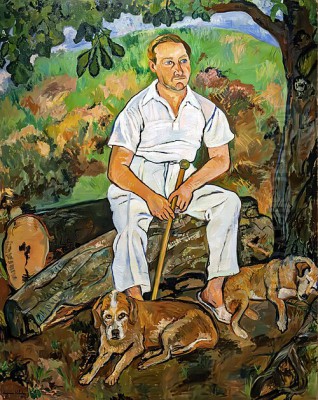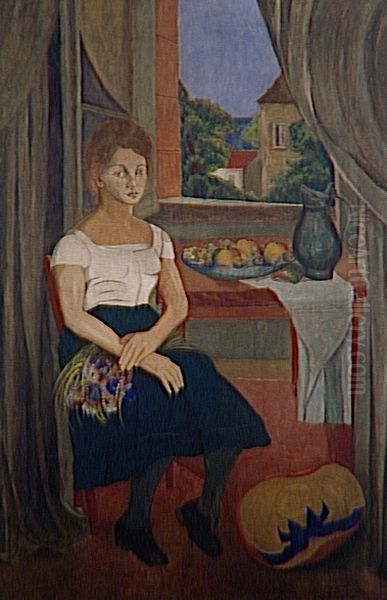
The vibrant, tumultuous art world of early 20th-century Paris, particularly the bohemian enclave of Montmartre, was a crucible for modern art. Amidst names that would become legendary, figures like André Utter played significant, if sometimes less globally heralded, roles. A painter in his own right, Utter's life and art are inextricably linked with two of Montmartre's most compelling personalities: Suzanne Valadon and her son, Maurice Utrillo. Understanding Utter requires delving into this intense ménage à trois, a relationship that fueled creativity, passion, and considerable drama.
Early Life and Parisian Roots
André Utter was born in the 18th arrondissement of Paris in 1886. His parents were of Alsatian origin, a detail that places his family background within a region of France with a distinct cultural identity, often caught between French and Germanic influences. Growing up in Paris, particularly in a district like the 18th which encompasses Montmartre, would have exposed him from an early age to the city's dynamic artistic and social currents. While specific details of his early artistic training are not extensively documented, it's clear he was drawn to the visual arts, a path that would lead him directly into the heart of Paris's most notorious artistic hub.
Montmartre at the turn of the century was more than just a geographical location; it was a state of mind. It was a haven for artists, writers, poets, and performers, attracted by its cheap rents, lively cabarets like the Lapin Agile and the Moulin Rouge, and a pervasive atmosphere of creative freedom and rebellion against bourgeois conventions. It was here that the seeds of Fauvism, Cubism, and other avant-garde movements were sown, with artists like Pablo Picasso, Georges Braque, Juan Gris, and Amedeo Modigliani congregating in studios like the Bateau-Lavoir.
The Fateful Encounter: Valadon and Utrillo
André Utter's life took a decisive turn around 1909. It was then, or shortly before, that he met Maurice Utrillo, a young painter already grappling with alcoholism but showing prodigious talent for capturing the melancholic soul of Montmartre's streets. Utrillo, born in 1883, was the son of Suzanne Valadon, herself a formidable figure in the Parisian art scene. Through Maurice, Utter was introduced to Valadon.

Suzanne Valadon (born Marie-Clémentine Valadon in 1865) had a life story as dramatic as any novel. Starting as a circus acrobat, a fall ended that career, leading her to become an artist's model. She posed for some of the greatest painters of the era, including Pierre-Auguste Renoir, Henri de Toulouse-Lautrec, and Pierre Puvis de Chavannes. Crucially, Edgar Degas recognized her raw talent for drawing, becoming a mentor and encouraging her to pursue her own art. Valadon was a fiercely independent woman, a pioneering female artist in a male-dominated world, known for her powerful, unidealized nudes and portraits.
The attraction between the younger Utter and the more established Valadon, who was twenty-one years his senior, was immediate and intense. By 1909, they had become lovers, embarking on a passionate and often stormy relationship. Utter, Valadon, and Utrillo soon formed what became known as the "trinité maudite" or "cursed trinity," a complex trio bound by art, affection, and shared struggles. They lived and worked together, often at Valadon's studio at 12 Rue Cortot in Montmartre, which is now part of the Musée de Montmartre.
Artistic Life in Montmartre
The period from roughly 1909 to the outbreak of World War I was incredibly fertile for all three artists. Utter, Valadon, and Utrillo stimulated and influenced one another. Valadon, already an accomplished artist, experienced a new surge of creativity. Utter, younger and still developing his style, found himself immersed in an environment of intense artistic production.
Utter’s own artistic output from this period included landscapes, still lifes, and portraits. His style, while individual, sometimes showed affinities with Valadon's bold lines and strong forms, though perhaps with a slightly softer, more classical inclination at times. He often served as a model for Valadon, most famously in her 1909 painting Adam and Eve, where Valadon depicted herself as Eve and Utter as Adam, a bold and modern reinterpretation of the biblical theme. Utter, in turn, also painted Valadon.
One of Utter's most significant works from this era is Le Lancement du Filet (The Casting of the Net), painted in 1914. This large canvas is a celebration of the male physique, depicting three heroic male nudes in a classical, almost Arcadian setting. Utter himself is said to have modeled for one or more of the figures. The work demonstrates his skill in rendering the human form and his engagement with both classical traditions and modern sensibilities. It stands as a testament to his ambition as a painter.
The trio exhibited together, and their work began to gain recognition. In 1912, Utter and Valadon held a joint exhibition in Munich, showcasing their intertwined artistic journeys. Their shared life was one of creative ferment, but also punctuated by Utrillo's battles with alcoholism and the inherent tensions of their close-knit, unconventional household. Artists like Amedeo Modigliani, who also lived and worked in Montmartre and was known for his distinctive portraits and nudes, were part of this broader artistic milieu, as were figures like Kees van Dongen, whose vibrant Fauvist portraits captured the era's energy.
The "Trinité Maudite" and Shared Creativity
The term "trinité maudite" hints at the complexities and difficulties of their shared existence. Maurice Utrillo, despite his artistic genius, was plagued by mental health issues and severe alcoholism from a young age. Valadon, as his mother, was fiercely protective and deeply concerned, while also navigating her own demanding artistic career and her relationship with Utter. Utter, in turn, became a sort of stepfather figure to Utrillo, who was only three years his junior. He often took on the role of managing Utrillo's affairs, trying to keep him on track, and promoting his work.
This dynamic, while challenging, also fostered a unique artistic synergy. They painted each other, painted the same scenes, and undoubtedly discussed art incessantly. The intensity of their relationships seems to have fueled their output. Valadon's portraits of Utter are powerful and revealing, capturing his youth and perhaps a certain intensity. Utter's depictions of Valadon and their shared environment provide glimpses into their domestic and artistic life.
The influence of Post-Impressionist masters like Paul Cézanne, Vincent van Gogh, and Paul Gauguin was still palpable in Paris, and younger artists were absorbing these lessons while forging new paths. The Fauvist explosion led by Henri Matisse and André Derain had already occurred, and Cubism was being developed by Picasso and Braque. Utter, Valadon, and Utrillo were working within this exciting, rapidly evolving artistic landscape, each carving out their unique niche.
Utter's Artistic Style and Contributions
While often discussed in the context of Valadon and Utrillo, André Utter was an artist with his own vision. His work often featured strong compositions and a clear appreciation for form. His landscapes, particularly those of Corsica where he and Valadon spent time, show a sensitivity to light and atmosphere. His nudes, like Le Lancement du Filet, demonstrate a robust, somewhat classical approach to the human figure, distinct from Valadon's more raw and confrontational nudes.
He was not an avant-gardist in the vein of Picasso or Braque, nor did he possess the haunting urban poetry of Utrillo or the fierce, groundbreaking modernism of Valadon. Instead, Utter's work often seems to bridge a gap between a more traditional, figurative approach and the modernist currents of his time. He was a skilled draftsman and a painter who understood color and composition.
His role as a manager and promoter of Utrillo's work, and to some extent Valadon's, was also significant. In a practical sense, he helped navigate the art market for them, particularly for Utrillo, whose erratic behavior could make business dealings difficult. This supportive role, while perhaps diverting some energy from his own painting, was crucial for the financial stability and growing fame of Utrillo.
Marriage, War, and Later Years
André Utter and Suzanne Valadon eventually married in 1914, just before the outbreak of World War I. The war inevitably disrupted their lives and the Parisian art scene. Utter was mobilized and served in the conflict. The experience of war often had a profound impact on artists of that generation, though its specific influence on Utter's subsequent work is a subject for deeper study.
After the war, the art world began to shift. Montmartre's heyday as the absolute center of the avant-garde was beginning to wane, with Montparnasse emerging as a new hub for artists like Chaim Soutine, Marc Chagall, and Man Ray. However, Valadon, Utrillo, and Utter continued to work and exhibit. Utrillo's fame, in particular, grew substantially in the 1920s, and his paintings of Montmartre street scenes became highly sought after.
The relationship between Utter and Valadon remained complex. They continued to live and work together for many years, but their passionate connection eventually frayed. They separated in the 1930s, though they never formally divorced. Suzanne Valadon died in 1938, an event that deeply affected both Utrillo and Utter. Present at her funeral were luminaries of the art world, including Picasso, Braque, and Derain, a testament to her standing.
André Utter outlived Valadon by a decade, passing away in 1948. In his later years, he continued to paint, though perhaps without the same public profile he had when associated with Valadon and the peak of Utrillo's emerging fame. His legacy remains somewhat overshadowed by his more famous wife and stepson. However, his contributions as a painter, as a key figure in their lives, and as a participant in the vibrant Montmartre art scene are undeniable.
Legacy and Reappraisal
André Utter's artworks can be found in various museum collections, particularly in France. While he may not have achieved the household-name status of some of his contemporaries, his paintings offer a valuable perspective on the artistic currents of his time. His work, especially pieces like Le Lancement du Filet, deserves appreciation for its own merits – its skilled execution, its engagement with the human form, and its place within the broader narrative of early 20th-century French art.
The story of André Utter is a reminder that art history is not just about a few towering geniuses, but also about the networks of artists who support, influence, and challenge one another. His life with Valadon and Utrillo was a microcosm of the passionate, often chaotic, but intensely creative world of Montmartre. He was a painter who navigated the complex interplay of personal relationships and artistic ambition, contributing his own voice to the rich chorus of Parisian modernism.
To fully appreciate Utter is to see him not just as an adjunct to Valadon and Utrillo, but as an artist who shared their world, contributed to their artistic dialogue, and created a body of work that reflects his own journey. His paintings, when viewed alongside those of his more famous companions, help to complete the picture of a remarkable artistic family and a pivotal era in the history of art. The intertwined lives and careers of Utter, Valadon, and Utrillo offer a compelling case study of artistic collaboration, rivalry, and mutual dependence, all set against the unforgettable backdrop of bohemian Paris. His connection to other artists of the period, even if indirect, places him within a web of creativity that included figures from the Impressionists like Renoir and Degas (through Valadon's modeling and mentorship) to the pioneers of modernism like Picasso and Modigliani who were his contemporaries in Montmartre.